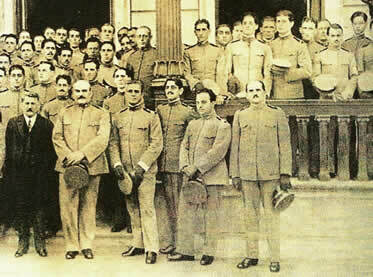After the first phase of the French Revolution, which took ten years, going from 1789 to 1799, the so-called Napoleonic era. Napoleon Bonaparte he remained in power for 15 years (10 of these 15 as emperor) and managed to mix various political elements and military strategies that gave his government an expansive potential that radically changed the history of Europe. In order for Napoleon to achieve his entire set of conquests in a relatively short time, he had to prepare a war machine that would give him due support. It was in this context that "The Great French Army” (“Grande Armee", in French).
For nearly a decade the Napoleonic army was considered invincible. The idea of a "Great Army", whose contingent was made up less of mercenaries, old and aristocratic soldiers and more by the people themselves, by the citizens of the State, already existed in germ in the waves of revolutions that occurred in England, in the century XVII. However, it was only with the advent of the French Revolution that this became really obvious.
In the first decade of the revolution, the divisions of the French army commanded by Napoleon achieved tremendous successes. This was due as much to the fact that his commander was a young general (Napoleon was in his twenties at the time) as to the fact of its soldiers to fight mobilized for the ideal of the “French Nation”, thus fighting as citizens of France, and not as subjects of the King. It was this belonging to a war machine made up of citizens that even scandalized one of the greatest war theorists of all time, the Austrian Carl von Clausewitz.
When he assumed central power in France at the time of the Consulate, Napoleon was already a respectable general. But from 1804 onwards, when he became emperor and began to undertake the Napoleonic Wars, Napoleon became a model and an idol for other nations, a stereotype of “liberator”, that is, liberator from the yoke of monarchical absolutism. However, this stereotype was built on the massive victories over absolutist monarchies such as the Prussian armies. To better understand the strength of the Napoleonic war machine, it is necessary to know of two modifications that the French army received in the 1790s.
According to historian Marco Mondaini, the first decisive change was:
Do not stop now... There's more after the advertising ;)
“Firstly, through the "Amalgam law" of February 21, 1793, the merger between the old battalion of troops is instituted. regulars (proud of their enthusiasm for the Revolution) and the new battalion of volunteers (proud of their enthusiasm for the Revolution Revolution). With this measure, the French army mixed technical capacity and ideological disposition.” [1]
After this fusion of army cadres, mixing old and experienced combatants with young imbued with ideology and vivacity, the second measure consisted in making the service mandatory. military:
“Second, after initiatives that are not always successful through the “Jourdan law”, of 5th of September 1798, military service for young people between the ages of 18 and 24 is permanently declared years old. With this legal imposition, the French army became a mass army, an army based increasingly on the forced recruitment due to declining spontaneous enlistments, but he carefully kept the speech of the volunteering." [2]
In 1810, at the height of the Napoleonic Empire, the great French army had about 610,000 fighters and 1,420 cannons, as well as occupied much of the European continent, going from the Iberian Peninsula to Poland. Napoleon's chief generals were, like him, young, and the bulk of his soldiers were fully politicized citizen soldiers.
As the main combat technique was the speed of displacements. This technique implied combat strategy on more than one battlefront, whose guiding principle was: always attack! Napoleon's army managed to be in various regions of the European continent and, in a few weeks, managed to close the encirclement on more than one enemy.
On the battlefield, the disposition of the French army happened as follows: a line of heavy artillery was formed, with cannons, very close to the enemy. Behind that line was the cavalry, ready to attack from behind and from the sides of the enemy formation. Right after the cavalry attack came the infantry attack, which completed the strategy.
GRADES
[1] Mondaini, Marco. “Napoleonic Wars”. In: Magnoli, Demetrius. (org.) History of Wars. São Paulo: Context, 2013. P. 202.
[2] Idem. P. 202.
By Me. Cláudio Fernandes

